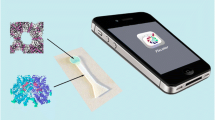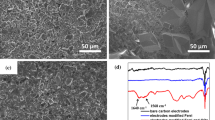Abstract
A simple paper-based optical biosensor for glucose monitoring was developed. As a glucose biosensing principle, a colorimetric glucose assay, using glucose oxidase (GOx) and horseradish peroxidase (HRP), was chosen. The enzymatic glucose assay was implanted on the analytical paper-based device, which is fabricated by the wax printing method. The fabricated device consists of two paper layers. The top layer has a sample loading zone and a detection zone, which are modified with enzymes and chromogens. The bottom layer contains a fluidic channel to convey the solution from the loading zone to the detection zone. Double-sided adhesive tape is used to attach these two layers. In this system, when a glucose solution is dropped onto the loading zone, the solution is transferred to the detection zone, which is modified with GOx, HRP, and chromogenic compounds through the connected fluidic channel. In the presence of GOx-generated H2O2, HRP converts chromogenic compounds into the final product exhibiting a blue color, inducing color change in the detection zone. To confirm the changes in signal intensity in the detection zone, the resulting image was registered by a digital camera from a smartphone. To minimize signal interference from external light, the experiment was performed in a specifically designed light-tight box, which was suited to the smartphone. By using the developed biosensing system, various concentrations of glucose samples (0–20 mM) and human serum (5–17 mM) were precisely analyzed within a few minutes. With the developed system, we could expand the applicability of a smartphone to bioanalytical health care.
Similar content being viewed by others
References
Whitesides G.M. The origins and the future of microfluidics. Nature 442, 368–373 (2006).
Zakir Hossain S.M. et al. Development of a Bioactive Paper Sensor for Detection of Neurotoxins Using Piezoelectric Inkjet Printing of Sol-Gel-Derived Bioinks. Anal. Chem. 81, 5474–5483 (2009).
Martinez A. et al. Simple Telemedicine for Developing Regions: Camera Phones and Paper-Based Microfluidic Devices for Real-Time, Off-Site Diagnosis. Anal. Chem. 80, 3699–3707 (2008).
Emanuel C., Andres W.M. & Whitesides G.M. Understanding Wax Printing: A Simple Micropatterning Process for Paper-Based Microfluidics. Anal. Chem. 81, 7091–7095 (2009).
Martinez A.W., Phillips S.T. & Whitesides G.M. Diagnostics for the developing world: microfluidic paperbased analytical devices. Anal. Chem. 82, 3–10 (2010).
Kevin M., Anna L.L., Jason A.K. & Andres W.M. Fully Enclosed Microfluidic Paper-Based Analytical Devices. Anal. Chem. 84, 1579–1585 (2012).
Emanuel C. et al. Paper Microzone Plates. Anal. Chem. 81, 5990–5998 (2009).
Andres W.M., Phillips S.T., Butte M.J. & Whitesides G.M. Patterned Paper as a Platform for Inexpensive, Low-Volume, Portable Bioassays. Angew. Chem. Int. Ed. 46, 1318–1320 (2007).
Andres W.M. et al. Programmable diagnostic devices made from paper and tape. Proc. Natl. Acad. Sci. U.S.A. 105, 19606–19611 (2008).
Andres W. et al. FLASH: A rapid method for prototyping paper-based microfluidic devices. Lab Chip 8, 2146–2150 (2008).
Andres W.M., Scott T.P. & Whitesides G.M. Diagnostics for the Developing World: Microfluidic Paper- Based Analytical Devices. Anal. Chem. 82, 3–10 (2010).
Abe K., Suzuki K. & Citterio D. Inkjet-Printed Microfluidic Multianalyte Chemical Sensing Paper. Anal. Chem. 80, 6928–6934 (2008).
Alina S., Marek S. & Krzysztof G. Impaired fasting glucose as a marker of heterogeneity of gestational diabetes mellitus. A study of 1025 women living in the region of Kuyavia and Pomerania in Poland Endokrynologia Polska 60, 348–352 (2009).
Son S.Y. & Yoon H.C. Electrochemical Analysis of Glycated Hemoglobin Based on the Biospecificity and Electron-Transferring Capability of Ferroceneboronic Acid. BioChip J. 2, 116–122 (2008).
Pawan K.T., Nam H.H. & Sohn Y.S. Correlation between blood glucose and hematocrit: A new estimation methodology BioChip J. 6, 206–212 (2012).
Han Y.D., Chun H.J. & Yoon C.H. The transformation of common office supplies into a low-cost optical biosensing platform. Biosens. Bioelectron. 59, 259–268 (2014).
Tamaoku K., Murao Y. & Akiura K. Determination of hydrogen peroxide by using a flow injection system with immobilized peroxidase and long pathlength capillary spectrophotometry. Anal. Chim. Acta 136, 121–127 (1982).
Alexandros C.P. et al. Determination of hydrogen peroxide by using a flow injection system with immobilized peroxidase and long pathlength capillary spectrophotometry. Analytica Chimica Acta 455, 305–313 (2002).
Andres W.M., Scott T.P. & Whitesides G.M. Threedimensional microfluidic devices fabricated in layered paper and tape. PNAS 105, 19606–19611 (2008).
Evelyne R. et al. Fasting plasma glucose versus glucose challenge test: screening for gestational diabetes and cost effectiveness. Clinical Biochemistry 37, 780–784 (2004).
Wei G. et al. Efficient bubble propulsion of polymerbased microengines in real-life environments. Nanoscale 19, 8909–8914 (2013).
Author information
Authors and Affiliations
Corresponding author
Rights and permissions
About this article
Cite this article
Chun, H.J., Park, Y.M., Han, Y.D. et al. Paper-based glucose biosensing system utilizing a smartphone as a signal reader. BioChip J 8, 218–226 (2014). https://doi.org/10.1007/s13206-014-8308-7
Received:
Accepted:
Published:
Issue Date:
DOI: https://doi.org/10.1007/s13206-014-8308-7




